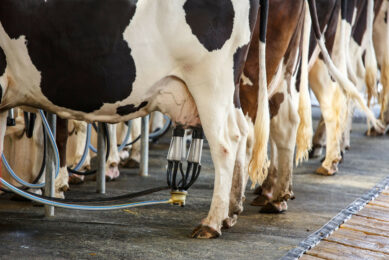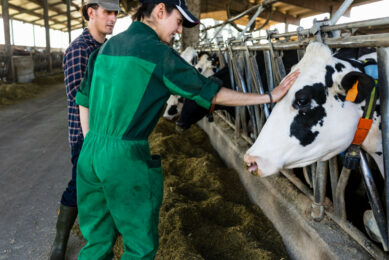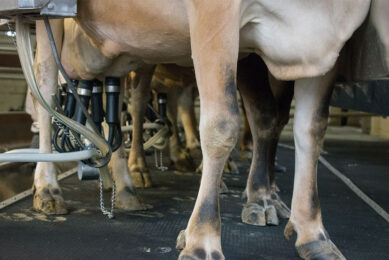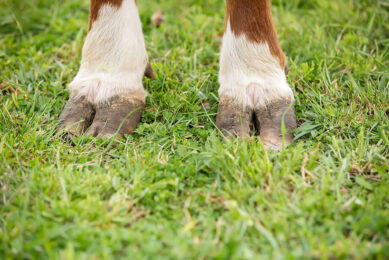Importance of managing digital dermatitis in youngstock
The amount of scientific research focusing on lameness has increased rapidly over the last decade, and the mature dairy cow is almost always the main research subject. One of the main causes of lameness in dairy cows is digital dermatitis (DD).
Lameness has a major impact on animal health, welfare and production. It is one of the main reasons for mature dairy cattle to be culled, next to mastitis and infertility. Combine this with the additional treatment costs and diminished milk production, and it results in major financial consequences for the dairy farmer (Willshire & Bell, 2009).

Several studies have identified first parity animals as the most susceptible to developing Digital Dermatitis (DD). The stressful experience around the first time calving, caused by environmental and metabolic changes, is suspected of causing a higher prevalence. However, the time before the first lactation is often overlooked. A small number of studies that did focus on DD in young stock found very interesting results.
Prevalence of Digital Dermatitis in young stock
A study in Alberta, Canada, studied the prevalence of DD in young stock older than 12 months. In 11 DD positive herds, the DD prevalence in young stock > 12 months was 9.9% (95% CI: 7.8 – 12.0) (Jacobs et al., 2017). In Denmark, the pre-calving heifer prevalence for DD was 15% (data from 5 herds, 4 months before calving) (Capion et al., 2009). An even higher DD prevalence for heifers was found in a study from Wisconsin, where the prevalence was 21% in 1 herd (at 21 months of age) and 30% at a mean age of 23 months (Gomez et al., 2015).
This is problematic since these studies also showed the following consequences for lactating dairy cows:
- DD in young stock increases the risk and severity of DD after calving
The presence of DD in young stock is associated with an increased DD prevalence in the lactation stage. When the young stock is exposed to an environment with a high DD risk, more severe DD lesions were observed after calving (Laven & Logue, 2007; Jacobs et al., 2017; Gomez et al., 2015; Holzhauer et al., 2012).
- Lower heifer DD prevalence has a positive effect on hoof health and treatment costs in the 1st lactation
A study by Gomez et al. monitored the percentage of animals that received treatment for DD in the 1st lactation in 3 groups: heifers with no DD in the rearing period, one DD treatment in the rearing period and several DD treatments in the rearing period. The percentage of animals that received treatment for DD in the first lactation was 13.7%, 45.6% and 67.6%, respectively (Table 1). (Gomez et al., 2015). Previous studies have shown that first lactation cows have the greatest odds for DD, which shows the importance of controlling DD in this specific group (Somers et al., 2005; Rodriguez-Lainz et al., 1999).
- DD status as heifer impacts reproduction in the 1st lactation
Cows without DD in the rearing period had a higher conception rate compared to cows with DD in the rearing period. The conception rate after the first insemination was monitored again in 3 groups: heifers with no DD in the rearing period, one DD treatment in the rearing period and several DD treatments in the rearing period. The results were 42.3%, 36.3% and 29.0%, respectively (Table 1) (Gomez et al., 2015), which confirms the importance of DD control in young stock once again.
Also read: Can floor type affect cattle performance?
Healthy hooves in young stock, DD reservoir
It is often hypothesised that young stock may act as a DD reservoir, in which the causative agent can be transmitted to lactating cattle after calving. By implementing hoof health protocols preventing DD infections in young stock, major problems may be prevented in the lactation stage, including chronic cases of DD.
As foot-bathing is often not a practical application for young stock, alternative prevention measurements are needed. Individual spraying with a low-pressure sprayer or an automatic sprayer is easier, more practical and gaining in popularity compared to footbaths. Intra Hoof-fit Spray has been specially developed as a ready to use rinsing liquid for spot spraying on the hoof. The strong adhesion provides a long contact time (over 9 hours) and reduces waste on the floor or in the manure pit (Roijackers et al., 2019).
The weekly use of Intra Hoof-fit Spray maintains, supports and promotes healthy hooves and dermis.
References available on request.
Source and for more info: Intracare



